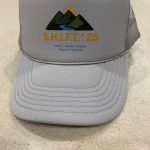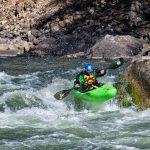Fraser River listed as third most endangered
The Fraser River in Grand County has been listed by American Rivers report as the third most endangered river in the United States. The Fraser faces threats to its very survival as a river, not just its viability. The Fraser is the “Poster Child” for Colorado’s over-used rivers.The Fraser heads up at Berthoud Pass, with tributaries flowing in from the Vasquez Mountains and the west slope of the Front Range. It comes down into Winter Park and Fraser, flows through ranch land and Tabernash into the Fraser Canyon, which holds a Gold Medal trout fishery. Out of the Canyon it passes through the Sol Vista resort, the town of Granby and joins with the Colorado River just above the Windy Gap Reservoir. President Eisenhower fished these waters to relieve the pressures of the White House.The Fraser is threatened by pollution and diversions, with diversions being the biggest threat. Currently Denver Water siphons nearly 65 percent of its flow through its Northern Delivery system. In 2002 and 2003 the Fraser very nearly disappeared. Denver has plans to increase their diversions by another 18,000 acre-feet, bringing their total share of the river to around 85 percent. This additional diversion is currently winding through the NEPA process, and the Draft Environmental Impact Statement (DEIS) should come out later this year or in 2006.The pollution troubles come from the fact that there might not be enough water below the Moffat Tunnel to sufficiently dilute the effluent from the waste water treatment plants. This will eventually cause problems for the folks who provide these services to the Fraser Valley, as well as for its residents and many visitors.To be fair, Denver Water is not the only diverter from the Fraser, nor may the situation be as dire as the American Rivers report implies. The towns of Winter Park and Fraser also rely on the river for water, as do the large ranches downstream. The ski areas pull water out for snowmaking and wells deplete the ground water feeding the river during low flow times.The Fraser is getting hammered from all over, but the largest hammer is held by Denver Water. Denver Water also holds the future of the Fraser, as a river, in its grasp.The DEIS will offer several alternatives by which the pending Moffat Collection System enlargement might be achieved. How the final alternative is selected and implemented will decide how, and if, the Fraser becomes any less a river. If Denver Water opts for a “preferred alternative” that simply takes more water with no consideration for the Fraser River ecosystem or the communities of the Fraser Valley, than it should be denied as the American Rivers report suggests. Hopefully that won’t happen and Denver Water will work with the Fraser Valley communities to develop an alternative that will benefit both sides of the Continental Divide, and especially the Fraser River.Much the same scenario is also playing out on the upper Colorado River, at Windy Gap. The Northern Colorado Water Conservancy District is planning a project of their own which will increase their diversion from the river by another 28,000 acre feet, or 10,000 acre feet more than Denver is planning to take. The cumulative impacts of these two projects could be devastating to the upper Colorado, depending on how they are done.Projects like these are being considered all along the Colorado River headwaters counties. Increased diversions are being scrutinized from the Blue River and Dillon Reservoir, from the Eagle, Fryingpan and Roaring Fork. Even the Gunnison has a Front Range target on its water. The Yampa isn’t too far away either.The Statewide Water Supply Initiative, which has been examining the water needs of Colorado, held one of its Basin Roundtable meetings in Glenwood Springs last month and an interesting, even surprising idea came up. It was proposed that maybe it’s time to re-think the way we think about water. That was a surprising statement, especially as it came from a couple of old-fashioned water users, a rancher and a water provider. “Man bites dog” is a more common practice than re-thinking Colorado’s water heritage and tradition for these folks. Others have been chewing on this bone for some time.They even spoke of a “paradigm shift,” which is what will be truly needed if we are going to get serious about Colorado’s rivers and our future. Re-thinking water will require a fundamental change in our underlying assumptions, our cultural “world view.” We need to shift from a paradigm that fixes a rivers’ primary role as a natural pipeline providing water to whoever holds the “best” right while disregarding the needs of all others. We are coming fast to a point where we should recognize the valid needs of others and the river itself. We need both more equitable solutions and ways of thinking about water and rivers. With any luck, and cooperation, we can do something for the Fraser before it becomes extinct. VTKen Neubecker writes about water and the environment for the Vail Trail. He can be reached for comment at eagleriver@eagleranch.com.










